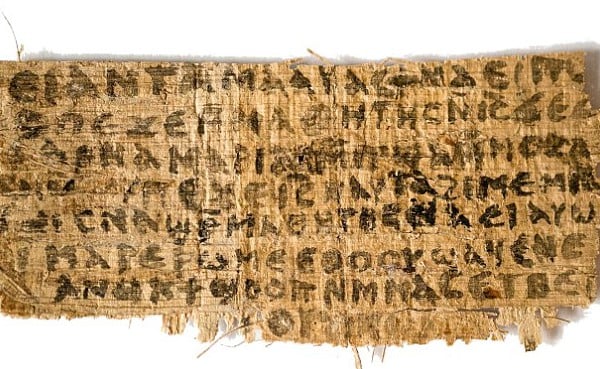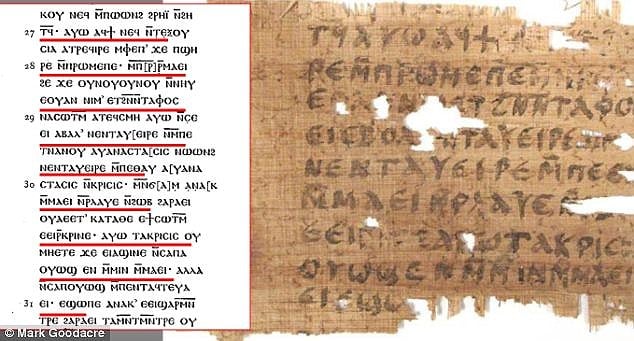Art World
New Evidence Emerges Authenticating Lost Gospel Mentioning Jesus Was Married
New evidence contradicts claims the papyrus fragment is a modern forgery.

New evidence contradicts claims the papyrus fragment is a modern forgery.

Sarah Cascone

New scientific tests indicate that the controversial Gospel of Jesus’s Wife, which suggests Jesus might not have been celibate, could be authentic.
The key line from the papyrus scrap reads “Jesus said to them, ‘My wife . . . she will be able to be my disciple.'” Elsewhere, the Coptic text mentions Mary, possibly in reference to Mary Magadalene, famously recast as Jesus’s wife in Dan Brown’s art historical thriller The Da Vinci Code, which spawned many a conspiracy theory.
When the manuscript came to light thanks to Harvard University professor Karen King in 2012, it was met with a great deal of skepticism. Roughly the size of a business card, the papyrus scrap was widely dismissed—the Vatican was among the detractors—as a modern forgery.
According to the Harvard Theological Review Journal, the papyrus and the ink are about 1,200 years old (it’s believed to be dated to sometime between the sixth and the ninth centuries. (Harvard is also home to the recently-discovered Gospel of the Lots of Mary.)
The main evidence against the discovery is the similarity of the text to a fragment of a rare copy of the Bible’s Gospel of John, written in Lycopolitan, the same obscure Coptic dialect used in the Gospel of Jesus’s Wife.
The two manuscripts have several of the exact same phrases and line breaks, and some suspect both are modern forgeries, especially given that Lycopolitan went extinct 1,500 years ago.
“The two Coptic fragments clearly shared the same ink, writing implement and scribal hand. The same artisan had created both essentially at the same time,” argued Christian Askeland, a research associate with the Institute for Septuagint and Biblical Research in Wuppertal, Germany, in a recent paper in the New Testament Studies journal.

The Gospel of Jesus’s Wife compared to an online version of an ancient Coptic copy of the Gospel of John.
Photo: Harvard Divinity School.
John Yardley, a senior research scientist at Columbia University, disputes these findings. “In our first exploration, we did state that the inks used for the two documents of interest were quite different. The more recent results do confirm this observation strongly,” he told Live Science.
For King’s part, she argues that both Coptic texts could be ancient copies of earlier texts, and that the similarity of the line breaks is coincidental.
She also discounts any resemblance to the early Christian text the Gospel of Thomas, including the inclusion of a typo found in an online version of the text. King contends that ancient scribes were not infallible, and made grammatical errors.
The papyrus’s current owner has not shared his identity with the world, but the provenance he has provided remains in dispute.
The owner claims to have purchased the fragment in 1999 from a German man named Hans-Ulrich Laukamp, who acquired it in Potsdam, in East Germany, in 1963. Laukamp died in 2002. Those who knew him say he never collected antiquities, and, as a West Berlin resident, he could never have visited Potsdam at the time he is said to have purchased the gospel.
King claims to have photocopies of signed papers confirming the owner’s account. If compared to confirmed instances of Laukamp’s signature on publicly available notarized documents, these contracts could verify the current owner’s account.

Hans-Ulrich Laukamp’s signature for September 1997.
For now, the Gospel’s authenticity is still very much up for debate.
“At this point, when discussions and research are ongoing, I think it is important, however difficult, to stay open regarding the possible dates of the inscription and other matters of interpretation,” said King in a recent letter to the Biblical Archaeological Review.
Related Stories:
See the Most Controversial Depictions of Jesus in Art
St. Francis Manuscripts Come to New York
Botched Restoration Of Jesus Fresco Miraculously Saves Spanish Town
Jesus’s Ancient Stomping Grounds Discovered at Galilean Hotel